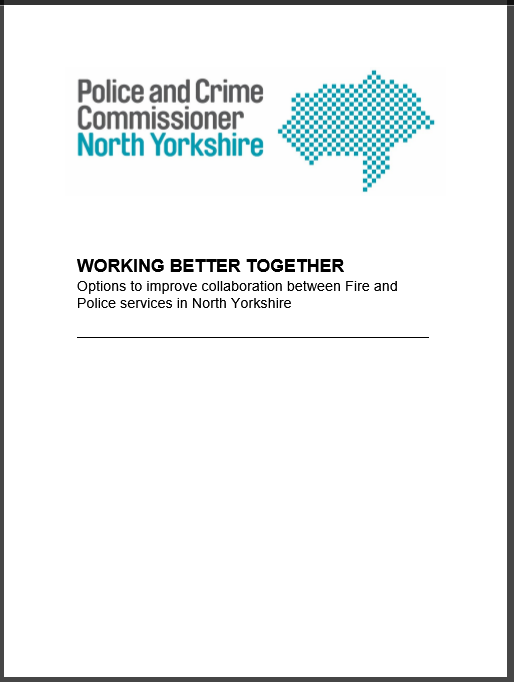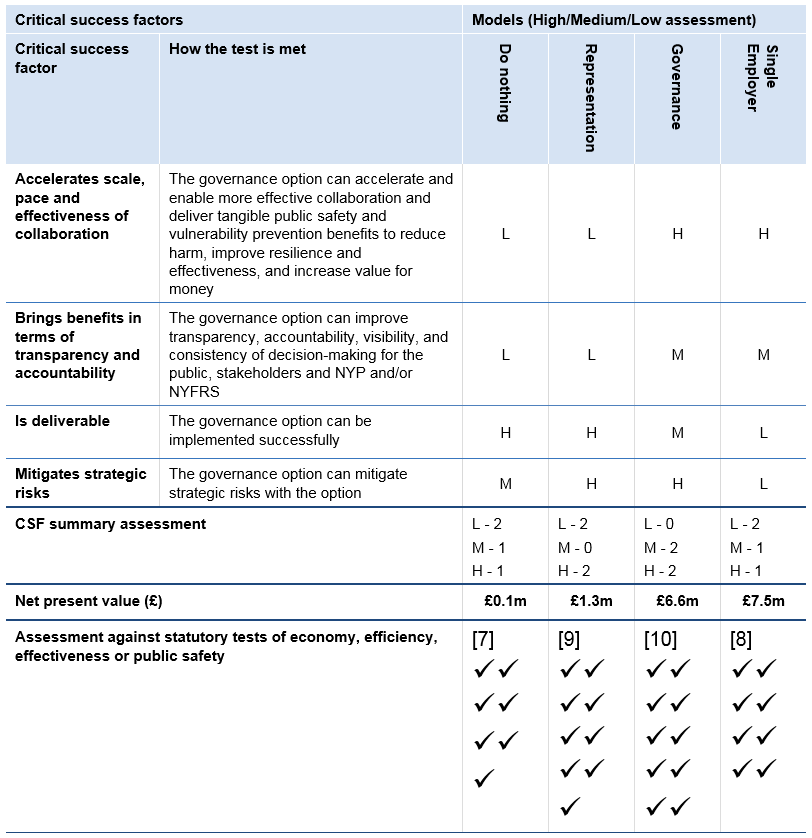The business case – July 2017
In depth analysis of the options, costs and benefits
The business case – Working better together
Introduction
 The Policing and Crime Act 2017 places a statutory obligation on emergency services to collaborate and enables Police and Crime Commissioners to take on responsibilities for fire and rescue services in their area. In describing the measures, Brandon Lewis, former Police and Fire Minister, said that “by overseeing both police and fire services, I am clear that PCCs can drive the pace of reform, maximise the benefits of collaboration and ensure best practice is shared.”
The Policing and Crime Act 2017 places a statutory obligation on emergency services to collaborate and enables Police and Crime Commissioners to take on responsibilities for fire and rescue services in their area. In describing the measures, Brandon Lewis, former Police and Fire Minister, said that “by overseeing both police and fire services, I am clear that PCCs can drive the pace of reform, maximise the benefits of collaboration and ensure best practice is shared.”
This Local Business Case assesses the scale of opportunity for closer working between police and fire in North Yorkshire, and then considers which of the joint governance options would be most likely to deliver the greatest range of opportunities at the greatest pace and with least risk, in the interest of public safety. This Local Business Case has been prepared by the Office of the Police and Crime Commissioner for North Yorkshire.
Download the business case – Working better together (July 2017)
Summary of the business case
The case for change
The strategic case for a change to the current model of governance of fire and rescue and police services in North Yorkshire is clear. Given the structure, size and budgets of the two organisations, and the shared challenges in demand and finances that they face, closer working is inevitable.
- North Yorkshire is the largest county in England with diverse rural and urban communities and a growing, and ageing, population
- Demand is changing with a growing focus on protecting vulnerable people
- There are increasing strains on public finances and a national drive for efficiency in order to avoid cuts to frontline services
However, while there has been some collaboration to date, this has been limited in ambition, has progressed slowly, and has been led tactically rather than having been strategically developed.
- Examples include collaboration on estates, procurement, and vehicle servicing
- One barrier has been issues of sovereignty over individual services
There are considerable drivers for change, with evidence showing that more joined up governance accelerates collaboration.
- Nationally, the Government is clear that change must happen
- Locally, stakeholders all agree that collaboration does not happen fast enough and that change is needed
- Research shows that the PCC model speeds up decision making and is more transparent and engaged with the public
- Evidence shows that joining up governance can improve collaboration by simplifying decision making processes
Local collaboration could and should go much deeper and faster.
- To improve public safety the future governance model needs to be able to provide strong, cross-organisational leadership, improving service resilience and effectiveness by reinvesting savings into frontline services
Options assessment
To facilitate better collaboration and improve emergency services, the Policing and Crime Act 2017 proposes three alternative options to the current model of governance for the Fire and Rescue Service.
Taking into account the context and drivers set out above, the business case assesses these options to identify which option is most likely to achieve the greatest acceleration of the pace of collaboration, the greatest scale of ambition for collaboration, and the greatest degree of transparency and accountability.
-
Representation model
The PCC is represented on a Fire and Rescue Authority (and its committees) in their police area with full voting rights, subject to the consent of the Fire and Rescue Authority. In North Yorkshire, this would see the PCC join NYFRA.
The Representation model would bring tangible changes, with the PCC becoming the 17th voting member on the NYFRA and having a formal vote in the new Collaboration Committee. Whilst this model could contribute to delivering the priority opportunities identified and bring additional external scrutiny to fire matters, the option is unlikely to drive a significant change in the pace or scale of collaboration. As a governance model it would continue to require multiple decision-making mechanisms and relies upon joint agreement of objectives and priorities. It would not therefore deliver significant savings, making it more difficult for police and fire to meet the financial and operational challenges set out in the Strategic Case. It is however low-risk and could be a stepping stone to more significant changes in the future. This model would not harm public safety, but it would not bring extensive improvements to public safety either.
-
Governance model
The PCC takes on legal and overarching responsibility for the provision of the fire and rescue service(s) in their area. Individual services retain their operational independence, budgets, their Chief fire Officer or Chief Constable, and their own staff. In North Yorkshire, this would see the PCC becoming the NYFRA.
The Governance model would bring a material change. Based on the evidence set out in the Strategic Case, it would speed up the pace of collaboration within police and fire, and with other partners, due to simplified, aligned decision-making structures. It could make transformational change more likely, with a greater likelihood of enabling joint commissioning strategies, and cross-organisational investment and resourcing decisions, bringing with it greater likelihood of achieving improvements to services for the public. It would bring more significant financial benefits that could be re-invested in frontline services. It would also enable the mechanisms used by the PCC to engage with the public to apply to fire, and increase scrutiny of fire and rescue matters. There will be some implementation costs and risks, but they are considered manageable. This model would not harm public safety, and could bring significant improvements in public safety.
-
Single Employer model
The PCC would become the NYFRA but, in addition, fire and rescue functions are delegated to a single Chief Officer for policing and fire. Within this model, the services remain distinct frontline services with separate budgets, albeit supported by increasingly integrated support services.
The Single Employer model could bring greater benefits than the Governance model, through providing the means to achieve deeper integration of fire and police assets while maintaining operational separation. Joint management structures would create greater joined up operational practice, and could move the services from two organisations to a single community safety service in the future. It would bring significant savings that could be reinvested in frontline services. However, it also brings significant delivery and strategic risks. Therefore, while it could bring significant improvements to public safety, there is a risk that it would harm public safety if it results in disruption.
Preferred option
Based on the assessment of the options, the preferred option is the Governance model.
It is assessed that this model is most likely to achieve the greatest acceleration of the pace of collaboration, the greatest scale of ambition, and the greatest degree of transparency and accountability, bringing meaningful savings, whilst being deliverable and sufficiently mitigating against strategic and public safety risks.
It is therefore most likely to deliver a transformative vision for collaboration against the context and drivers set out in the case for change. It is most likely to further enhance and improve public safety.
Summary
A summary of the analysis of the options is set out below. Details of the evidence behind the assessment is set out in the full business case.
Download the Summary of the business case

